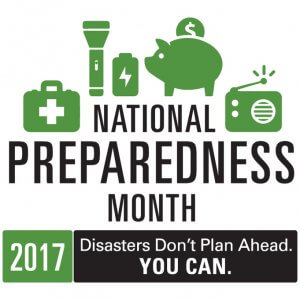September is National Emergency Preparedness Month – an initiative created by FEMA and the Department of Homeland Security to help better prepare the general public for emergency situations and natural disasters. Mother Nature has been especially tough in August and September as several hurricanes and tropical storms have ravaged the southern and eastern United States. Coastal states – particularly Texas and Florida – were hit the hardest, and suffered a great deal of devastation. The goal of National Emergency Preparedness Month is to spread awareness about the most effective ways to protect yourself, family and property in the event of an emergency or natural disaster.
Be in the Know
A good starting point for being prepared is simply having access to information. When a natural disaster, for example, is forecast, make sure to understand when, how and who it will affect. Regularly follow your local news stations and city or town leaders to be in the know. While it is well known that not every forecast is 100% accurate, the adage “better safe than sorry” applies here. It is better to have more information about a potential emergency or natural disaster than to be blindsided.
Be in Touch
Make sure to regularly communicate with your friends, family and other loved ones who may live in an area unaffected by the emergency/natural disaster in your area. Social media websites such as Facebook now offer the ability to mark yourself as “safe” during an emergency or natural disaster, providing peace of mind to those who care about your wellbeing. It is also a good idea to have emergency contacts, such as your local electric and natural supplier, saved in your phone to quickly report outages and emergency-related issues.
Emergency Kit
It is recommended to have an emergency kit available in areas that you frequent, such as your home, workplace, and car. A home and workplace emergency kit should have essentials that will come in handy. FEMA recommends that your kit contains, at a minimum, the following items:
- Water – one gallon of water per person per day for at least three days, for drinking and sanitation.
- Food – at least a three-day supply of non-perishable food and a can opener.
- Battery-powered or hand crank radio and a NOAA Weather Radio with tone alert.
- Flashlight with batteries.
- First aid kit with band-aids, gauze, scissors, antiseptic.
- Extra batteries and light bulbs.
- Whistle to signal for help.
- Dust mask to help filter contaminated air and plastic sheeting and duct tape to shelter-in-place.
- Moist towelettes, garbage bags and plastic ties for personal sanitation.
- Wrench or pliers to turn off utilities.
- Cell phone with chargers and backup batteries
Being prepared in the event of an emergency or natural disaster can help you and your loved ones stay safe and informed during a very difficult and trying time.

